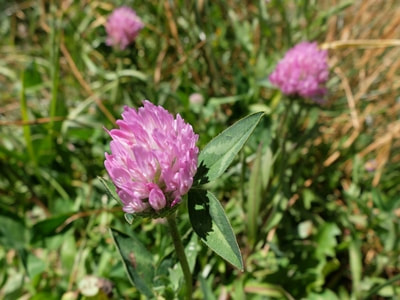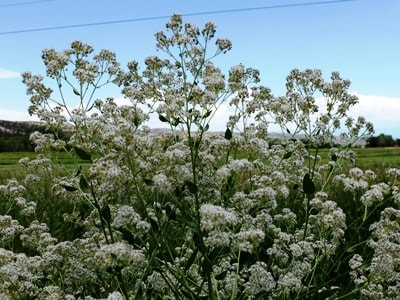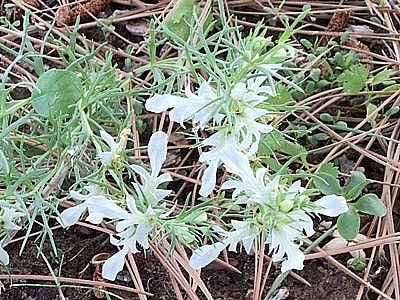|
Found in meadows, pastures, roadsides
Seen blooming in July in Abiquiu The common name of Red Clover is confusing as the flowers are more a rose pink to pink/purplish, not true red. It is not native to the Americas but has become naturalized and can be found growing wild in grassy locations that are not regularly mowed. It is grown as a forage crop for pasturage, hay and green manure for livestock. It can be easily distinguished from other varieties of clover by the large pink flower heads as well as the lighter green V-shaped marking that appears on the leaflets. Its flowers have a honey-like fragrance. The flowering heads and foliage are both edible, raw or cooked. Its young leaves should be harvested before the plant blooms. They can be used in salads or soups or cooked similar to spinach. The flowering heads as well as the seed pods can be dried and used as a flour substitute. The young flowers can also be eaten raw in salads. They taste sweet or like hay but they are not easily digestible. Do not eat the flowers if pregnant or nursing. Historically, Red Clover was used for asthma, whooping cough, cancer, and gout. Today, extracts from Red Clover are most often promoted for menopause symptoms, high cholesterol levels, or osteoporosis. Source. If you are trying to identify a different flower then you can check what other flowers bloom this month. If you cannot identify a flower from the website, send a photo and where you took it to [email protected]. Read online for tips.
1 Comment
Found in disturbed areas, wet areas, ditches, roadsides, pastures
Seen blooming in July along Hwy 554 in El Rito Perennial Peppergrass grows 3 to 5 feet tall with numerous woody stems and oval-shaped waxy leaves on the stems and long strap-like basal leaves. It has an extensive root network, known to reach 9 feet in depth. Tiny, fragrant flowers grow in dense clusters. It is considered an invasive species in many areas and is listed as a noxious weed in New Mexico and Colorado. The leaves, shoots, and fruits of this plant are all edible. In Ladakh in the Himalayas, the spring leaves are prized as a vegetable. The peppery edge or bitterness is removed by first boiling the young shoots and leaves, and then soaking in water for two days. Cooked like spinach, it makes a nutritious vegetable. Source. In England, this cousin of watercress was called "pepper herb" because of its spicy and bitter taste but it is mainly for its medicinal properties that it has been known since the Middle Ages. In the 13th century, Hildegarde de Bingen wrote about it: "What it contains sour and bitter does not attack the man inside, but heals him. A man with a weak heart and a sick stomach will eat the raw Lepidium and strengthen it. Likewise, those who are sad will regain their joy. If eaten, it heals the eyes and makes them clear”. The website of Les Benedictines de Chantelle, a French monastery, has some interesting stories about this weedy plant. If you are trying to identify a different flower then you can check what other flowers bloom this month. If you cannot identify a flower from the website, send a photo and where you took it to [email protected]. Read online for tips. Found in dry, open areas
Seen blooming in July near Hwy 554 in Abiquiu Lacy Germander grows to 8 inches tall, often in colonies, with densely leafy stems. The leaves are deeply cut. The plant’s aromatic blooms are showy, white, and funnel-shaped, crowded at the top of erect stems, sometimes with purple lines at the throat. Flowers have a lower petal two or three times longer than the other petals, looking like a landing pad for pollinators. There are no Native American uses for this plant, but other plants in this genus are used to treat gastrointestinal disorders, inflammations, diabetes and rheumatism. Source. The Santa Fe Extension Master Gardener says that Lacy Germander is a good source of nectar for bees and butterflies. That it is deer resistant, evergreen and quite sturdy, holding up to New Mexico’s strong spring winds. It often forms a dense mat in sunny, unirrigated areas. In the home landscape it can be used as a groundcover, in borders, or in perennial gardens. Source. If you are trying to identify a different flower then you can check what other flowers bloom this month. If you cannot identify a flower from the website, send a photo and where you took it to [email protected]. Read online for tips. Found in meadows, roadsides
Seen blooming in July in Abiquiu There are many species of white daisies that grow in our area from early spring through the summer. One of the common ones blooming now is the Whiplash Daisy which grows in colonies of plants that are from 4 to 10 inches tall. Basal leaves are narrow and bluish-green. This daisy is easy to identify from the runners (stolons) it produces which sometimes take root at the tip and expand the colony. The bright white flowers are about ½ inch across with a yellow center, many rays and a touch of pink below, as can be seen on the closed buds in the photo. Traditionally, the plant was used as a ceremonial medicine; to treat spider bites and snake bites; as an eyewash for livestock; and tied together in bunches to make brooms. Source. If you are trying to identify a different flower then you can check what other flowers bloom this month. If you cannot identify a flower from the website, send a photo and where you took it to [email protected]. Read online for tips. |
AuthorI am Marilyn Phillips, a native of England, whose love of nature and the outdoors from childhood brought me by a circuitous route to Crested Butte, Colorado in 1993 and 16 years later to northern New Mexico. My exploration of the many trails in these areas, my interest in wildflowers and photography, and career in computer system design came together in this creation. If you have any corrections, comments or questions, please contact me by email. Archives
September 2025
Categoriescopyright © 2020
|






 RSS Feed
RSS Feed